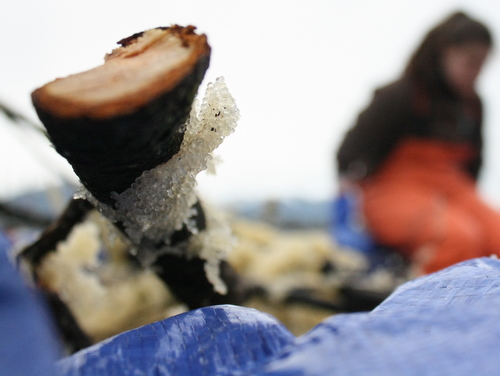
Herring roe clings to a hemlock branch in the back of a pickup truck as representatives from the Sitka Tribe of Alaska bring branches ashore. After years of smaller subsistence harvests, STA is suing the state, claiming mismanagement of the herring fishery (KCAW File Photo/Ed Ronco)
A tribal government is filing suit against the State of Alaska, alleging mismanagement of the Sitka sac roe herring fishery. The Sitka Tribe of Alaska has retained a major Anchorage law firm that specializes in tribal advocacy and subsistence issues. KCAW’s Katherine Rose reports on the build-up to this moment over the future of Sitka’s sac roe herring fishery.
For 20 years, tribal leaders have been worried about the health of Sitka’s herring. The silvery fish return every spring to spawn and are pursued by commercial fisherman, subsistence harvesters, and marine mammals alike. As a forage fish, they’re a cornerstone of the ecosystem.
Herring rock is blessed with water to mark this seasonal moment.
Audio: “This is spring. We are getting ready for our season. This is our time for work. Gunalchéesh.”
Jessie Johnnie told the story of herring rock to the Board of Fish in 1997 — one of a young Tlingit woman sitting on the rock and lowering her hair into the ocean for the herring to lay their eggs. “All the herring would come to the rock and swim around,” she said, “and she would sing lullabies to them.”
Herring have cultural, ecological, and economic significance for Sitka. But the message to the Board of Fish back then was that the herring weren’t spawning the same way in the same places, and subsistence harvesters were struggling to gather enough roe.
Herman Kitka, testifying at that 1997 meeting, feared for the worst. “If nothing is done,” he said, “we will lose the herring stock that is left in Sitka Sound.”
In 2018, his son Harvey Kitka went before the Board of Fish to say the same thing: Act now, or potentially lose our herring. Sitka Tribe proposed capping the commercial harvest of herring at 10-percent. But the Board took no action, maintaining a formula that calculates a sliding scale of 12- to 20-percent depending on the size of the biomass.
KCAW’s Emily Kwong spoke with Kitka afterwards. He said he wasn’t surprised by the Board’s decision, but wondered if his father’s forecast was coming true.
“It’s happening right now, what we were concerned about back then,” Kitka said. That was January of this year. In March, the herring fishery opened and ran into trouble. Now, the thing you need to know about the commercial herring fishery is it’s driven by processors. They need fish of a certain quality to market their product, largely to Japan and other Asian countries.
Area management biologist Eric Coonradt said the fish this year — most of which were four year olds — were simply too small.
“The quality with which processors needed to market these fish was 125 g or better and 11% roe or better and if you look at our forecast, 92% of the fish didn’t meet that demand,” said Coonradt. In other words, they were looking for the biggest and best fish out there, but didn’t find enough. The fleet fell over 8,000 tons short of their quota and the commercial fishery closed early for the fourth time in six years. The fishery is driven by the formula and Coonradt noted, it’s up to the Board of Fish to change it. “Unless we had a biological concern, we couldn’t close this fishery ourselves. What they’d have to do is bring it to the Board of Fish as an emergency petition. That’s their option,” he said.
Subsistence harvesters didn’t have much luck either. Jeff Feldpausch is the Resource Protection Director for Sitka Tribe. His team is bagging hemlock branches covered with eggs for distribution to elders. He points to bare spots on the branches.

Jeff Feldpausch stands in front of bags of hemlock branches, ready for distribution to elders. He noted the bare spots on the branches, illustrating the annual need for subsistence coming up short (Photo/KCAW Emily Kwong)
“People don’t want trees in their freezer, it’s all about putting eggs in their freezers not branches,” said Feldpausch. “This is looking grim. This is really grim.”
Although the harvest was insufficient for both commercial and subsistence purposes, the state is preparing for next season’s fishery under the same model. In December, the Alaska Department of Fish and Game announced they anticipate a spawning mass of 64,000 tons of herring in Sitka Sound, around 9000 more pounds than was originally predicted — and set a commercial quota at 20-percent of that forecast.
This infuriates the Sitka Tribe of Alaska. On Tuesday, December 11, STA filed a lawsuit against the Alaska Department of Fish and Game and the Alaska Board of Fisheries in Superior Court. They’re not calling for an all-out closure of the fishery. They’re asking for an injunction against ADF&G requiring them to develop a new management plan for the fishery prior to the start of the season next March. The Tribe also wants the court to find that the actions of the Board of Fish and Alaska Department of Fish and Game are illegal under Alaska law.
In a press release on Friday, STA chair KathyHope Erickson called for protection of the subsistence way of life. “The time is now,” she said “to ensure our people have the chance to fulfill their cultural responsibilities which have been interwoven with the herring since time immemorial, and to fill their freezers. We cannot sit by while the State of Alaska shirks its statutory and constitutional duties to citizens. We demand action by the state.”
The Tribe has retained the Anchorage law firm of Landye Bennet Blumstein as legal counsel. The State of Alaska has 30 days to reply to the suit.






























